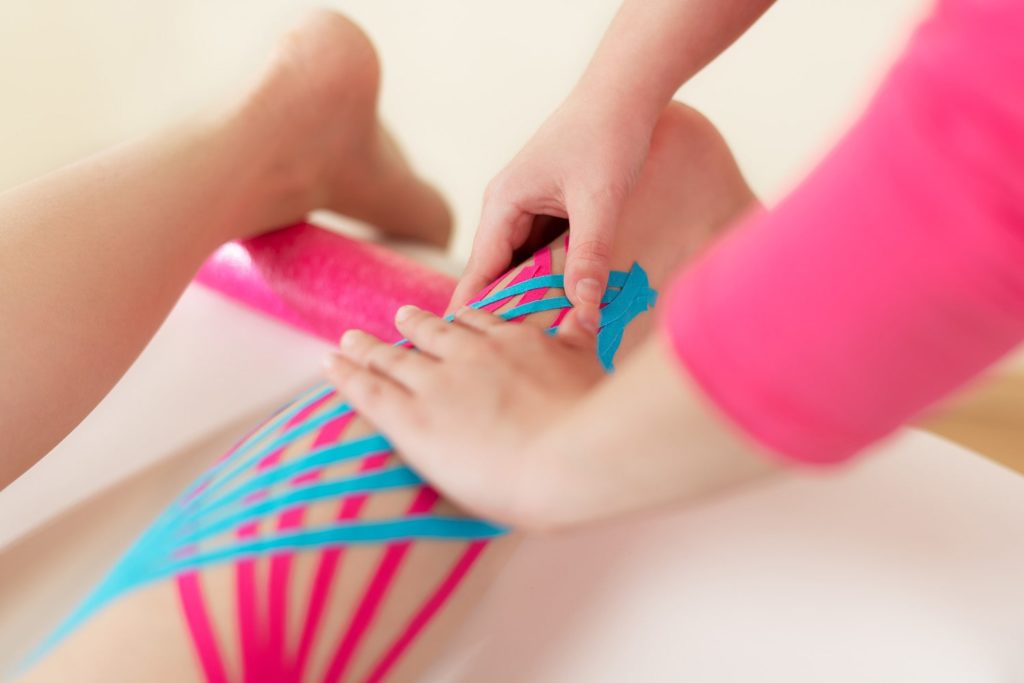Kinesiotaping is a dynamic cutting of various parts of the body with special elastic bands. In this article, we will briefly present the history of kinesiotaping and explain its use. We also characterize kinesiofilm tapes and suggest methods that can be used to apply kinesio tapes.
A Brief History of Kinesiopathy
The method was developed in the 1970s by the Japanese chiropractor Kenzo Kase, who, after several years of clinical research, introduced a new treatment method. In 1995, the American National Athletic Coach Association recognized kinesiotaping as an effective adjunctive treatment. In Europe, it was widespread in the mid-1990s, and at the beginning of the 21st century, Polish physiotherapists incorporated it into rehabilitation methods. Today tapes are widely used in physical therapy, especially in the sports sector.

What are kinesiofilm tapes?
kinesiofilm tapes are made of 100% cotton coated with hypoallergenic acrylic glue. The tapes are designed to simulate human skin. They extend only in the longitudinal direction, and their elasticity is up to 130% of the original length. They are waterproof and do not interfere with daily activities (including bathing). Their use is possible for up to a week.
Using kinesiotaping
Kinesiotaping uses stimulation by mechanical stimulation of skin receptors. The use of a number of techniques allows the achievement of the correct functioning of the muscular and osteoarticular systems. When applied correctly, we can achieve:
-
- improve blood circulation,
- correct muscle tone,
- correct alignment of the joint surface,
correct mobility of the fascia,
- reduce lymphatic edema,
- relieve pain.
Methods for kinesiocable tapes
Before discussing the wrapping techniques, the shapes of kinesiofilm tapes should be introduced as there is a significant relationship between them. The main forms of tapes that we use for kinesiotaping:
- “I”
- “Y”
- “X”
- “Network”
- Fan.

Basic Kinesio tape methods:
- Muscle suppression application: we glue the skin to the muscles from its end attachment to the initial attachment, the tape tension is 15-25%. We usually use ribbons “I”, “Y” and “X”.
- Muscle support application: we attach the skin to the muscle from its initial to final attachment, the tension of the tape is 15-35%. We use ribbons “I” and “Y”.
- Mechanical correction. We use it to correctly position the articular surfaces in a neutral position. We use 75-100% belt tension. We use ribbons in the shape of the letters “I” and “Y”. We use, for example, for hallux valgus correction.
- Fascial correction: we use to restore correct mobility. We use 10-50% tension and the “I” and “Y” straps. For example, we use dysfunction of the iliotibial zone.
- Spatial correction: the goal of correction is to increase the distance between tissues and thus reduce pain. We use a tension of 25-35% of the tape and an “I” shape to form a star. We use it, for example, at trigger points.
- Lymphatic / Cardiovascular Correction: Its task is to drain excess fluid from the tissues and increase the intercellular space, which facilitates the movement of fluid. The tension is 10-15% of the fan-shaped belt. We use, for example, lymphatic edema of the extremities.
